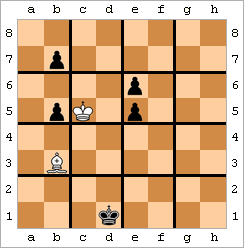Here are two math puzzles, solve, comment and enjoy the discussion!
Puzzle 1: Prime NumbersSection titled Puzzle 1: Prime Numbers
Prove that is divisible by 24, where is a prime number with .
This is a simple one - do not go by the technicality of the problem statement.
Solution 1Section titled Solution 1
Given, is a prime number , and are even. We can also write,
Given, , either or are also even. Hence, is divisible by .
Furthermore, as is prime, we can write it as either or , where . In either case, one of or are divisible by 3 as well.
Hence, is divisible by .
Puzzle 2: Hopping on a Chess BoardSection titled Puzzle 2: Hopping on a Chess Board
On a chess board, basically a grid, how many ways one can go from the left most bottom corner to the right most upper corner? In chess naming conventions, from to .
In the original post this problem was ill defined.
Please solve this problem with the constraints that only up and right
moves are allowed.

Can you find the generic answer for the case of grid?
Solution 2Section titled Solution 2
For an grid, we need only right and up moves.
Thank you Devin for pointing this out.
Given only forward moves are allowed, for any arbitrary grid of , a total of moves are needed.
Any of these moves can be of type right and of type up. In short, this is a combinatorial problem of distributing objects into groups of and . This is simply,
In the particular case of the chess board, . Hence, total number of possible paths are:
Thank you Rohit and Amber for posting quick solutions!
Let me know if you have any other interesting alternative solutions to these problems.
COMMENTS